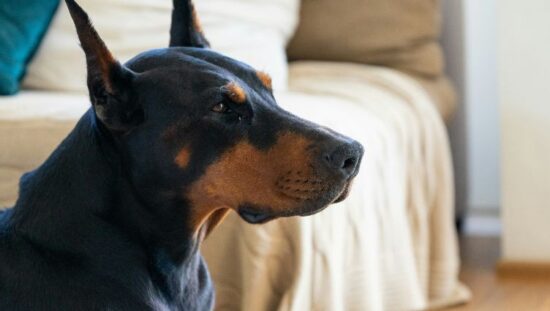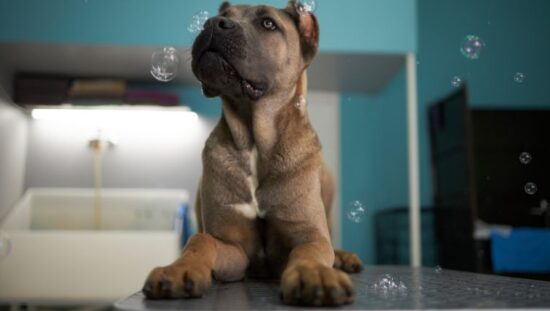Keeping your dog’s paws in good shape is really important for their overall health. Their paw pads go through a lot, from walking on rough surfaces to dealing with hot and cold weather.
With the right care, you can help prevent injuries and keep your dog comfortable and happy. In this guide, we’ll share simple tips for taking care of your dog’s paws, showing you how to keep them healthy. Let’s get started!

Understanding Dog Paw Pads
Dog paw pads are special and important parts of their feet. Each pad is made of thick skin, fat, and tissue, which work together to do a few important jobs:
-The rough surface of paw pads helps dogs hold onto the ground, preventing them from slipping, especially when running or climbing.
-The fat inside the pads helps keep their feet warm in the cold and cool in the heat, protecting them from extreme temperatures.
-Paw pads cushion their bones and joints by absorbing shocks. This helps prevent injuries and keeps them comfortable while walking or running.
Common Paw Pad Problems
Dog paw pads are tough, but they can still get hurt and cause pain. Problems like cracks, dryness, cuts, scrapes, burns, and blisters can make it hard for your dog to walk and run comfortably. These issues often come from everyday activities, bad weather, or walking on rough or hot surfaces. It’s important to check your dog’s paw pads regularly and help prevent these problems. Let’s talk about them in more detail:
1. Cracks and Dryness
Cracks and dryness in your dog’s paw pads can be uncomfortable and painful. This often happens when the pads lose moisture, so they become rough and split. Walking on hard surfaces, like concrete, or exposure to extreme weather can make this worse.
To help prevent cracks and dryness, regularly check your dog’s paws and keep them clean. You can also apply a dog-safe moisturizer to keep the pads soft and hydrated. Make sure your dog avoids walking on very hot or cold surfaces, which can dry out and crack their paw pads even more. Regular care can keep your dog’s paws smooth and healthy.
2. Cuts and Abrasions
Cuts and abrasions on your dog’s paw pads can happen easily. Sharp objects like glass, rocks, or even rough ground can cause these injuries. When your dog’s pads are cut or scraped, it can be like when humans get cuts on their feet. Just like it’s painful for us to walk or run with cuts, it’s the same for dogs.
To prevent cuts and abrasions, try to avoid taking your dog over rough or dangerous surfaces. Keep an eye out for broken glass or other sharp objects when you’re out for walks. If your dog does get a cut or scrape, clean the area gently with warm water and apply a dog-safe antiseptic. You should cover the paw with a bandage to keep it clean while it heals. Regularly checking your dog’s paws can help you catch and treat any cuts or abrasions quickly.
3. Burns and Blisters
Burns and blisters on your dog’s paw pads can happen from walking on very hot surfaces, like pavement in the summer, or extremely cold surfaces, like ice in the winter. These injuries can cause a lot of pain and make it difficult for your dog to walk.
To prevent burns and blisters, avoid taking your dog out during the hottest part of the day in the summer or on icy ground in the winter. You can check the pavement’s temperature by placing your hand on it for a few seconds; if it’s too hot for your hand, it’s too hot for your dog’s paws. In cold weather, you can use dog booties to protect their paws from ice and salt.
If your dog does get burns or blisters, gently clean the area with cool water and apply a dog-safe soothing balm. Keep your dog off rough surfaces until their paws heal to avoid more irritation.
Preventive Care Tips for Dog’s Paw Pad
Taking good care of your dog’s paw pads is important for their overall health and comfort. Regularly checking your dog’s paw pads is the first step in preventive care. This helps you catch any problems early before they become serious. Keeping the pads moisturized is also crucial, because this prevents dryness and cracking. Additionally, using protective measures like dog booties or avoiding harsh surfaces can significantly reduce the risk of injuries.
1. Regular Inspections
Checking your dog’s paw pads regularly is important to keep them healthy and happy. Look for any signs of cuts, scrapes, cracks, or redness on the pads. If you notice anything unusual, like limping or licking of the paws, it’s important to examine them closely. By catching any problems early, you can prevent them from getting worse and make sure your dog stays comfortable.
To inspect your dog’s paw pads, gently lift their paw and examine the bottom. Make sure to check between the toes as well. If you see anything concerning, such as an object stuck in the paw or a cut, clean the area with mild soap and water. If the issue seems serious, it’s best to contact your vet for further advice.
2. Moisturizing Paw Pads
Just like our skin, their paw pads can get dry and rough, especially in hot or cold weather. To help keep their paw pad healthy, you can use a dog-safe moisturizer or balm.
Before applying any product, make sure to clean your dog’s paw pads thoroughly with a gentle soap and warm water. Once they’re clean and dry, gently massage the moisturizer into their pads, focusing on any dry or rough areas. Be sure to choose a product specifically designed for dogs, because human moisturizers can have ingredients that are bad for them.
Putting moisturizer on your dog’s paw pads often, especially after they’ve been in rough weather, can help keep their pads soft and bendy.
3. Protective Measures
To keep your dog’s paws safe, there are some easy steps you can take. As we mentioned above, avoid walking them on really hot or really cold surfaces, like pavement on a hot day or icy sidewalks in winter. If it feels uncomfortable for your hand, it’s probably not good for their paws either.
Think about using dog booties or paw wax to add extra protection. Booties can shield their paws from hot pavement or rough ground, while paw wax forms a barrier against harsh weather and chemicals like salt on roads in winter.
It’s also a good idea to trim the hair around their paw pads regularly. This helps prevent moisture and dirt from getting trapped, which can lead to irritation or infection.
First Aid for Injured Paw Pads
If your dog hurts their paw pads, it’s important to quickly give them first aid to make them feel better and stop more problems. Here are some simple steps you can take:
- Clean the Wound: Gently wash the injured paw pad with mild soap and warm water to remove dirt. Pat the area dry with a clean towel.
- Apply Antiseptic: Use a dog-safe antiseptic solution to disinfect the wound and prevent infection. Be sure to follow the instructions on the product label.
- Protect the Paw: If the injury is minor, you can apply a dog-specific paw pad balm or petroleum jelly to soothe the area and create a protective barrier. For more serious injuries, consider covering the paw with a clean bandage or gauze pad to keep it clean and stop further irritation.
- Limit Activity: Encourage your dog to rest to let the hurt paw pad to heal properly. You may need to use a dog bootie or bandage to protect the paw when going outside.
- Monitor for Signs of Infection: Keep an eye on the hurt paw pad for any signs of infection, such as redness, swelling, or discharge. If you notice any concerning symptoms, call your vet for help.
Seasonal Paw Pad Care – Summer and Winter
Taking care of your dog’s paw pads is super important in summer and winter. Here’s what you can do:
In the summer, you need to watch out for hot ground, like pavement, sand, and asphalt, because they get really hot in the summer sun. Walk your dog in the cooler parts of the day or on the grass to avoid burns. Dog booties or paw wax can protect their pads from getting burnt on hot surfaces.
Another important thing is to keep them hydrated. Make sure your dog drinks plenty of water. It helps keep their paw pads from drying out too much.
In the winter, avoid icy roads. Ice and cold can make their pads dry and cracked. Try to keep them off icy sidewalks and roads. After walks, wipe their paws to get rid of salt and chemicals from the roads. They can irritate their pads.
Also, moisturize their pads with special dog balm or petroleum jelly to keep them soft and healthy.
Conclusion
Taking care of your dog’s paw pads is important all year round. By following these tips, you can keep their paws healthy and happy, no matter the season. Remember to check their pads regularly, protect them from extreme temperatures, and give gentle care when needed. With a little attention and love, your dog can enjoy their walks and adventures without any paw problems.
If you’re interested in learning more about grooming your dog’s paws and keeping them comfortable, check out our blog post on How to Trim Dogs Paws for step-by-step instructions and helpful tips.



